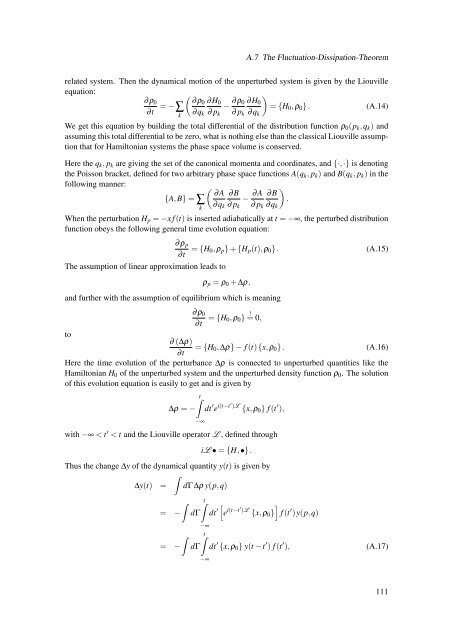Diffusion Processes with Hidden States from ... - FU Berlin, FB MI
Diffusion Processes with Hidden States from ... - FU Berlin, FB MI
Diffusion Processes with Hidden States from ... - FU Berlin, FB MI
You also want an ePaper? Increase the reach of your titles
YUMPU automatically turns print PDFs into web optimized ePapers that Google loves.
A.7 The Fluctuation-Dissipation-Theoremrelated system. Then the dynamical motion of the unperturbed system is given by the Liouvilleequation:(∂ρ 0 ∂ρ0 ∂H 0=∂t−∑ − ∂ρ )0 ∂H 0= {H 0 ,ρ 0 }. (A.14)k∂q k ∂ p k ∂ p k ∂q kWe get this equation by building the total differential of the distribution function ρ 0 (p k ,q k ) andassuming this total differential to be zero, what is nothing else than the classical Liouville assumptionthat for Hamiltonian systems the phase space volume is conserved.Here the q k , p k are giving the set of the canonical momenta and coordinates, and {·,·} is denotingthe Poisson bracket, defined for two arbitrary phase space functions A(q k , p k ) and B(q k , p k ) in thefollowing manner:( ∂A ∂B{A,B} = ∑ − ∂A )∂B.k∂q k ∂ p k ∂ p k ∂q kWhen the perturbation H p = −x f (t) is inserted adiabatically at t = −∞, the perturbed distributionfunction obeys the following general time evolution equation:∂ρ p∂tThe assumption of linear approximation leads to= {H 0 ,ρ p } + {H p (t),ρ 0 }. (A.15)ρ p = ρ 0 + ∆ρ,and further <strong>with</strong> the assumption of equilibrium which is meaning∂ρ 0= {H 0 ,ρ 0 } = ! 0,∂tto∂ (∆ρ)= {H 0 ,∆ρ} − f (t){x,ρ 0 }. (A.16)∂tHere the time evolution of the perturbance ∆ρ is connected to unperturbed quantities like theHamiltonian H 0 of the unperturbed system and the unperturbed density function ρ 0 . The solutionof this evolution equation is easily to get and is given byˆt∆ρ = −−∞dt ′ e i(t−t′ )L {x,ρ 0 } f (t ′ ),<strong>with</strong> −∞ < t ′ < t and the Liouville operator L , defined throughiL • = {H,•}.Thus the change ∆y of the dynamical quantity y(t) is given byˆ∆y(t) = dΓ∆ρ y(p,q)ˆ= −ˆ= −ˆtdΓ−∞ˆtdΓ−∞[ ]dt ′ e i(t−t′ )L {x,ρ 0 } f (t ′ )y(p,q)dt ′ {x,ρ 0 } y(t −t ′ ) f (t ′ ),(A.17)111









